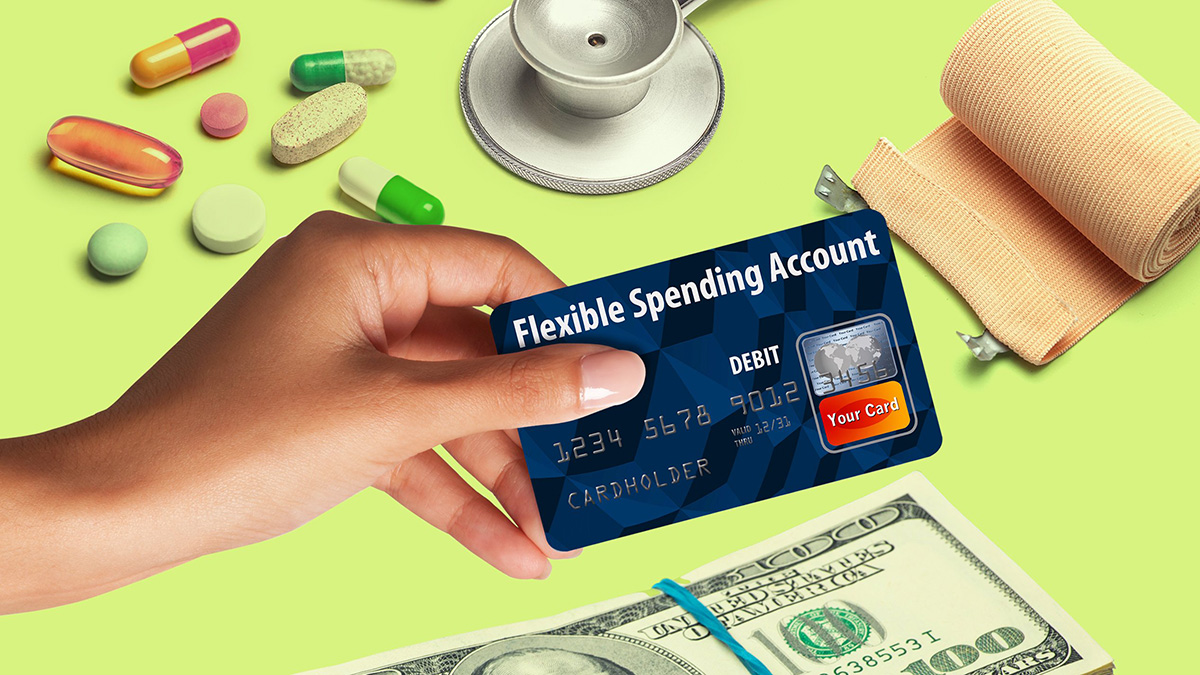

Finance
What Is A Flexible Spending Credit Card
Published: November 11, 2023
Learn how a flexible spending credit card can help you manage your finances. Find out the benefits and how to apply for a finance-friendly card today.
(Many of the links in this article redirect to a specific reviewed product. Your purchase of these products through affiliate links helps to generate commission for LiveWell, at no extra cost. Learn more)
Table of Contents
- Introduction
- What is a Flexible Spending Credit Card?
- How Does a Flexible Spending Credit Card Work?
- Benefits of a Flexible Spending Credit Card
- Drawbacks of a Flexible Spending Credit Card
- How to Get a Flexible Spending Credit Card
- Tips for Using a Flexible Spending Credit Card Efficiently
- Frequently Asked Questions (FAQs) About Flexible Spending Credit Cards
- Conclusion
Introduction
Welcome to the world of flexible spending credit cards! If you are seeking a convenient and efficient way to manage your healthcare expenses, you have come to the right place. In this article, we will explore the ins and outs of flexible spending credit cards and how they can benefit you. Whether you are looking to save money on medical costs or simplify your healthcare budgeting, a flexible spending credit card could be the solution you’ve been searching for.
A flexible spending credit card is a financial tool designed specifically for healthcare expenses. It allows you to set aside pre-tax dollars from your salary or income to use on eligible medical expenses. These cards are particularly popular among those who have employer-sponsored health plans with a flexible spending account (FSA) or a health reimbursement arrangement (HRA).
With the ever-increasing costs of medical care, it’s essential to take advantage of every opportunity to save money. Flexible spending credit cards provide a convenient way to manage your healthcare expenses while potentially reducing your taxable income. By understanding how these cards work and maximizing their benefits, you can optimize your healthcare budget and make informed financial decisions.
In the following sections, we will delve deeper into the specifics of flexible spending credit cards, explore their functionality, weigh their benefits and drawbacks, and provide tips for using them efficiently. By the end of this article, you will have a comprehensive understanding of flexible spending credit cards and be equipped to make informed decisions regarding your healthcare expenses.
What is a Flexible Spending Credit Card?
A flexible spending credit card is a specialized payment method that allows individuals to use pre-tax dollars from their flexible spending account (FSA) or health reimbursement arrangement (HRA) for eligible medical expenses. These cards are typically issued by employers or financial institutions and can be used at healthcare providers, pharmacies, and other medical service providers.
Unlike a traditional credit card, a flexible spending credit card is linked to your FSA or HRA account. It allows you to access the funds allocated for healthcare expenses without the need to pay out-of-pocket and seek reimbursement later. This makes it a convenient and hassle-free way to cover medical costs as they arise.
One key feature of a flexible spending credit card is that it is typically issued with a specific purpose in mind. Most cards are designed to cover only medical expenses, ensuring that the funds are used for their intended purpose. This helps individuals maintain accountability and ensures compliance with the Internal Revenue Service (IRS) guidelines on qualifying medical expenses.
When you use a flexible spending credit card, the funds are deducted directly from your FSA or HRA account. This means that you don’t have to worry about repayment or accruing interest charges. The card acts as a convenient bridge between your healthcare expenses and your tax-advantaged account, allowing for seamless payment without the need to carry cash or use a separate credit card.
To take full advantage of a flexible spending credit card, it’s important to understand the specifics of your FSA or HRA plan. Different plans may have varying rules and regulations regarding eligible expenses, spending limits, and rollover options. Familiarize yourself with the terms and guidelines of your plan to ensure you make the most out of your flexible spending credit card.
In the next section, we will explore how a flexible spending credit card works and the benefits it offers to cardholders.
How Does a Flexible Spending Credit Card Work?
A flexible spending credit card functions similarly to a regular credit card but with a few key differences. Instead of being tied to a traditional credit line, it is linked to your flexible spending account (FSA) or health reimbursement arrangement (HRA) funds. Here’s how it works:
- Allocation of funds: At the beginning of the plan year, you determine the amount of money you want to contribute to your FSA or HRA. This amount is then divided into equal installments and deducted from your paycheck on a pre-tax basis. These funds are accessible using your flexible spending credit card.
- Card activation: Once your FSA or HRA funds have been allocated, your employer or financial institution will provide you with a flexible spending credit card. This card will be linked to your FSA or HRA account and can be used to pay for eligible medical expenses.
- Using the card: When making a purchase or receiving a medical service, simply present your flexible spending credit card as you would any other payment card. In most cases, you will not be required to provide any additional documentation. The card’s payment processing system will automatically deduct the amount from your FSA or HRA funds.
- Tracking expenses: It is important to keep track of your flexible spending credit card transactions and receipts for record-keeping purposes. This will help you stay on top of your healthcare expenses and ensure compliance with IRS regulations.
- Replenishing funds: Throughout the plan year, as you incur eligible medical expenses, your FSA or HRA funds will be used to cover those costs. However, if you exhaust your account balance, you may need to pay out-of-pocket until the next plan year or until your account is replenished. Be mindful of your account balance and plan your healthcare expenses accordingly.
- End of the plan year: It’s important to note that FSA and HRA funds are typically “use it or lose it,” meaning they do not roll over into the next plan year. In some cases, employers may offer a grace period or a carryover amount, but it’s best to familiarize yourself with the terms of your specific plan. Be sure to utilize your remaining funds before the plan year ends.
By understanding how a flexible spending credit card works, you can take full advantage of its benefits and optimize your healthcare budgeting. In the next section, we will explore the advantages of using a flexible spending credit card.
Benefits of a Flexible Spending Credit Card
Using a flexible spending credit card offers several advantages for individuals looking to manage their healthcare expenses more efficiently. Let’s explore some of the key benefits:
- Convenient and streamlined payments: A flexible spending credit card simplifies the payment process for eligible medical expenses. Instead of paying out-of-pocket and seeking reimbursement, you can use the card to pay directly from your FSA or HRA funds. This saves time and eliminates the need for manual paperwork.
- Tax savings: One of the major benefits of utilizing a flexible spending credit card is the potential tax savings. By contributing pre-tax dollars to your FSA or HRA, you effectively reduce your taxable income. This means you pay fewer taxes overall, allowing you to keep more money in your pocket.
- Budgeting and expense management: With a flexible spending credit card, you can easily track and manage your healthcare expenses. The card statements provide a clear breakdown of your payments, allowing you to keep a close eye on your spending. This makes it easier to stick to your budget and make informed financial decisions.
- Accessibility to funds: A flexible spending credit card ensures you have quick and easy access to your allocated funds. Instead of waiting for reimbursement, you can use the card to pay for medical expenses as they arise. This is especially valuable in emergency situations or when unexpected healthcare costs occur.
- Wide acceptance: Flexible spending credit cards are widely accepted at various healthcare providers, including doctors’ offices, pharmacies, hospitals, and other medical service providers. This means you can use your card to pay for a range of eligible expenses, from prescription medications to hospital visits.
- Integration with healthcare plans: Flexible spending credit cards are typically integrated with employer-sponsored healthcare plans that offer FSAs or HRAs. This integration ensures seamless coordination between your benefits and the use of the card, making it easier to manage your healthcare expenses.
By taking advantage of these benefits, you can make your healthcare expenses more manageable and potentially save a significant amount of money. However, it’s important to consider the drawbacks of using a flexible spending credit card, which we will explore in the next section.
Drawbacks of a Flexible Spending Credit Card
While a flexible spending credit card offers numerous benefits, it’s important to be aware of the potential drawbacks as well. Consider the following limitations of using a flexible spending credit card:
- Use it or lose it: One of the main drawbacks of a flexible spending credit card is the “use it or lose it” policy. Typically, any unused funds in your FSA or HRA at the end of the plan year cannot be carried over. This means that if you don’t utilize your allocated funds within the specified timeframe, you forfeit the remaining balance.
- Eligible expenses limitations: While flexible spending credit cards can be used for a wide range of eligible medical expenses, there are certain limitations and exclusions. Not all medical services or products may be covered by your FSA or HRA plan. It’s important to familiarize yourself with the plan guidelines and consult with your healthcare provider or insurance administrator if you have any questions about eligible expenses.
- Account administration fees: Some flexible spending credit cards may come with administrative fees or charges associated with managing your FSA or HRA account. These fees can eat into your potential savings, so it’s essential to review the terms and conditions of your card before signing up.
- Limited access to funds: While flexible spending credit cards provide convenient access to funds, it’s important to remember that the card is tied to your designated account. This means that you can only use the funds for eligible medical expenses and not for other purposes. Additionally, the availability of funds may be restricted to the balance in your FSA or HRA account, so it’s crucial to monitor your account balance to avoid situations where you don’t have sufficient funds to cover a medical expense.
- Employment dependency: Another drawback of a flexible spending credit card is its dependence on your employment status. If you change jobs or become unemployed, you may lose access to the card and the associated FSA or HRA benefits. It’s important to understand the implications of changing employment and how it may affect your ability to use the card.
Considering these drawbacks, it’s essential to weigh the pros and cons of a flexible spending credit card and determine if it suits your individual circumstances and healthcare needs. Understanding the limitations will allow you to make informed decisions and ensure you get the most out of your healthcare budget and benefits.
How to Get a Flexible Spending Credit Card
If you are interested in getting a flexible spending credit card to help manage your healthcare expenses, here are the steps to take:
- Check your eligibility: First, determine if your employer offers a flexible spending account (FSA) or health reimbursement arrangement (HRA). These are the accounts typically associated with flexible spending credit cards. If your employer does not offer these benefits, you may have limited options for obtaining a flexible spending credit card.
- Enroll in a qualifying health plan: To be eligible for an FSA or HRA, you must be enrolled in a qualifying health plan, typically provided by your employer. These plans are often offered as part of a comprehensive employee benefits package. Familiarize yourself with the specifics of your health plan to verify eligibility for an FSA or HRA.
- Allocate funds to your FSA or HRA: Once you are enrolled in a qualifying health plan with an FSA or HRA, you will have the opportunity to allocate funds to the account. Determine the amount you wish to contribute each pay period, as per the limits set by the IRS and your specific plan. This amount will be deducted from your pre-tax income and made available in your FSA or HRA account.
- Obtain a flexible spending credit card: After you have allocated funds to your FSA or HRA, your employer or the financial institution managing your account will issue you a flexible spending credit card. This card will be connected to your FSA or HRA funds and can be used to pay for eligible medical expenses.
- Activate and use the card: Once you receive your flexible spending credit card, follow the activation instructions provided and familiarize yourself with the terms and conditions. You can then start using the card to pay for eligible medical expenses at participating healthcare providers and pharmacies.
- Keep track of your transactions: As you make purchases using your flexible spending credit card, it is important to keep track of each transaction. Save your receipts and review your card statements regularly. This will help you stay on top of your healthcare expenses and ensure accurate record-keeping for tax purposes.
If you are unsure about the process of obtaining a flexible spending credit card or need assistance, reach out to your employer’s HR department or the administrator of your FSA or HRA plan. They will be able to provide guidance and answer any questions you may have.
Now that you know how to get a flexible spending credit card, let’s explore some tips for using it efficiently in the next section.
Tips for Using a Flexible Spending Credit Card Efficiently
To make the most out of your flexible spending credit card and maximize your healthcare budget, consider the following tips:
- Understand your plan: Take the time to familiarize yourself with the specific details of your flexible spending account (FSA) or health reimbursement arrangement (HRA) plan. Understand the eligible expenses, contribution limits, and any restrictions or guidelines that may apply. This will ensure you stay within the allowed parameters and avoid any unexpected surprises.
- Plan ahead: Review your anticipated healthcare expenses for the year and estimate the amount you will need to allocate to your FSA or HRA. Consider regular expenses such as prescription medications, doctor visits, and preventive care. Planning ahead will help you allocate an appropriate amount and avoid any unspent funds at the end of the plan year.
- Keep track of expenses: Maintain a record of all healthcare-related receipts and documentation. This will help you stay organized and serve as proof of your eligible expenses in case of an audit or reimbursement verification. Many flexible spending credit card issuers provide online tools or mobile apps that allow you to track your transactions easily.
- Use your funds wisely: Be mindful of the amount of funds available in your FSA or HRA account and use it judiciously. Prioritize necessary healthcare expenses and avoid unnecessary spending. If you have remaining funds towards the end of the plan year, consider utilizing them for eligible items such as prescription eyeglasses or over-the-counter medications.
- Keep up with policy changes: Stay informed about any changes to your FSA or HRA plan. Policy updates may include adjustments to contribution limits, eligible expenses, or guidelines for reimbursement. Regularly review communications from your employer or plan administrator to ensure you are up to date with any changes that may affect your flexible spending credit card usage.
- Coordinate with other healthcare benefits: If you have other healthcare benefits, such as health insurance or a health savings account (HSA), coordinate your spending to maximize your savings. Be aware of which expenses are covered by each benefit and use your flexible spending credit card for expenses that are not covered by your insurance or HSA.
- Maximize preventive care: Take advantage of preventive care services that are often covered by FSAs or HRAs. These may include annual check-ups, vaccinations, and wellness screenings. Utilizing these services can help you maintain good health and potentially avoid more costly medical expenses in the long run.
By following these tips, you can effectively use your flexible spending credit card and optimize your healthcare budget. Remember to consult with your employer, plan administrator, or tax advisor if you have any specific questions or need personalized guidance.
Now, let’s address some frequently asked questions about flexible spending credit cards.
Frequently Asked Questions (FAQs) About Flexible Spending Credit Cards
Here are some common questions and answers about flexible spending credit cards:
- What expenses are eligible for payment with a flexible spending credit card?
Flexible spending credit cards can typically be used for a wide range of eligible medical expenses, such as doctor visits, prescription medications, dental care, vision care, and certain medical supplies. However, it’s important to consult your FSA or HRA plan guidelines to determine the specific eligible expenses. - Can I use my flexible spending credit card for non-medical expenses?
No, flexible spending credit cards are specifically designed for eligible medical expenses. Attempting to use the card for non-qualified expenses may result in penalties or the need to repay the charged amount. - What happens if I have unused funds at the end of the plan year?
In most cases, any remaining funds in your FSA or HRA at the end of the plan year will be forfeited. However, some employers may offer a grace period or allow a limited amount of funds to carry over into the next plan year. Be sure to review the terms of your specific plan to understand the options available to you. - Can I use my flexible spending credit card for dependent care expenses?
No, dependent care expenses are typically not eligible for payment with a flexible spending credit card. Separate arrangements, such as a dependent care flexible spending account (DCFSA), are available for qualifying dependent care expenses. - Can I have both a flexible spending credit card and a health savings account (HSA)?
In most cases, you cannot have both a flexible spending credit card and an HSA. However, there are exceptions for certain limited-purpose FSAs or HRA accounts that can be used in conjunction with an HSA. Speak to your employer or plan administrator to understand your specific options. - Can I use a flexible spending credit card for expenses incurred by my spouse or dependents?
Yes, you can use your flexible spending credit card to pay for eligible medical expenses incurred by your spouse or eligible dependents, even if they are not covered by your healthcare plan. - How do I know if a healthcare provider accepts a flexible spending credit card?
Most healthcare providers, including doctors’ offices, pharmacies, and other medical service providers, accept flexible spending credit cards. However, it’s always a good idea to check with the provider beforehand to confirm their acceptance of this payment method.
Remember, the answers provided here are general in nature, and it is always important to refer to the specific guidelines of your FSA or HRA plan to fully understand the terms and conditions.
Now, let’s conclude our discussion on flexible spending credit cards.
Conclusion
A flexible spending credit card can be a valuable tool for managing your healthcare expenses. By understanding what a flexible spending credit card is and how it works, you can make informed decisions about your healthcare budget and potentially save money in the process.
We explored the benefits of using a flexible spending credit card, such as the convenience of streamlined payments, potential tax savings, and better expense management. However, it’s important to be aware of the drawbacks, including the “use it or lose it” policy and limitations on eligible expenses.
To obtain a flexible spending credit card, you need to be eligible for an employer-sponsored flexible spending account (FSA) or health reimbursement arrangement (HRA). Allocating funds to your FSA or HRA and utilizing the card for eligible medical expenses can greatly simplify and streamline your healthcare budgeting.
To use a flexible spending credit card efficiently, it’s important to plan ahead, keep track of your expenses, understand your plan’s guidelines, and coordinate with other healthcare benefits. These tips will help you make the most of your healthcare funds and avoid any unnecessary expenses or penalties.
Remember to review your FSA or HRA plan documents and consult with your employer or plan administrator if you have any specific questions or concerns. They can provide you with the most accurate and up-to-date information regarding your flexible spending credit card and account.
By being proactive and informed, you can effectively utilize your flexible spending credit card, manage your healthcare expenses, and potentially save money on medical costs. Take advantage of this financial tool to make your healthcare budgeting a seamless and efficient process.
Thank you for joining us on this journey through the world of flexible spending credit cards. We hope this article has provided you with valuable insights and empowered you to make informed decisions regarding your healthcare expenses.














